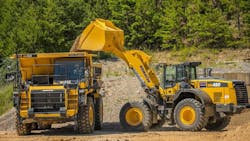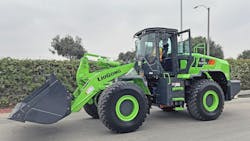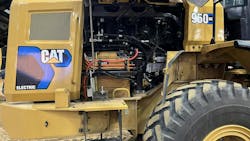OEMs boost technology offerings on large wheel loaders
Manufacturers of wheel loaders 200 horsepower and up have been busy adding technology to make operation easier and safer.
Managers have a good number of OEM choices in the category right now—and an interesting future with more hybrid electric and battery electric machines on the horizon.
There may even be hydrogen power coming (expect hydrogen to be a player well before methane).
The growth in technology introduces more choices for managers. It becomes even more important when viewed in the context of the ongoing qualified operator shortage.
Caterpillar, which already has a number of technologies in its wheel loaders in the category including AutoDig, Cat Payload with Assist, and ProductLink, will soon add Collision Warning with Motion Inhibit.
The feature uses Cat Smart Cameras and motion detection technology working together to stop machine movement when a hazard is nearby. It takes audible alarms and visual warnings on the display panel a step further.
Read also: Onboard cameras elevate job site safety
“Motion Inhibit supports operator awareness and site safety by preventing machines from moving until the area is clear,” said Todd Farmer, Caterpillar product manager for construction digital technology. “It will launch as a factory option by the end of the year, but there will be a retrofit kit available for our Next Generation loaders.”
Scott Schmidtgall, Caterpillar’s product application specialist for medium wheel loaders, said profiles in the latest Cat wheel loaders, including truck loading and dozing, allow operators to change change multiple application-based operating settings with one button.
“There’s also Cat Advanced Payload with Assist, with features like Tip Off Assist that automatizes load adjustment of the final bucket to match the hauling unit’s target,” Schmidtgall said.
Automatic start-stop systems conserve fuel by shutting off the engine when it’s not needed, according to a report in Power & Motion, an Endeavor Business Media sibling publication.
Develon has made what it calls Transparent Bucket technology (see video at left) standard on its wheel loaders over 200 horsepower. “The Transparent Bucket allows operators to see through the bucket using cameras mounted on the wheel loader,” said Develon wheel loader product manager Bill Zak.
Specifically, two cameras are mounted on the front of the loader. One is on top of the cab, the other on the bottom of the loader in front of the differential. With the press of a button, an algorithm kicks in and merges the two video feeds to create a ghost image that shows the operator what may be hidden by the bucket.
“Develon wheel loaders also come standard with a rearview camera,” Zak said. “Additional technologies available as options include an all-around view monitor (AVM) camera system and object detection system. The AVM provides up to 270 degrees of visibility for the operator. And the object detection system alerts the operator if there is an object too close to the machine.”
Develon’s “Smart Guidance System” gives operators tips for more efficient operation. “This may include giving operators tips for reducing fuel consumption,” Zak said. “Also available as standard equipment for our Dash 7 Series wheel loader is Situation Awareness Technology. This technology automatically monitors the wheel loader’s activity and adjusts engine output to match real- time requirements of the hydraulic system and drivetrain—whether the operator is loading, lifting, or hauling.”
What's the future for electric wheel loaders?
A proliferation of 200-horsepower-plus fully electric loaders in the market is still some time away due to issues with battery size and power.
However, Volvo Construction Equipment and LiuGong are upping the ante with larger battery-electric units. For instance, Volvo started small with the 29.5-horsepower L20 and L25 Electric models but is now readying a 20-metric-ton L120 Electric wheel loader for possible launch in North America next year. Europe will see it in the fourth quarter, Volvo said. For comparison’s sake, the conventional diesel L120 is a 272-horsepower machine.
Teased in North America during Conexpo 2023 was LiuGong’s 856HE, which checks in at 350 kWh translating to roughly 469
horsepower. They are no longer simply trade show fodder or hidden from view in faraway China—the Sanitation Districts of Los Angeles County already owns four of these units and is looking at acquiring more.
Caterpillar has shown journalists a 950GC prototype loader, along with a prototype fast charger. (The diesel version is 225 horsepower.)
John Deere has had hybrid loaders available for about a decade. The company’s 944 X-Tier features the E-Drive system, a hybrid-electric drivetrain. A 744 X-Tier wheel loader was shown at the last Conexpo but has not yet hit the market.
The hybrid-electric drivetrain consists of a John Deere 13.5L engine, gearbox, two 3-phase Alternating Current (AC) permanent magnet generators, power electronics or inverters, four 3-phase AC Switched Reluctance motors, four 2-stage reduction final drives, and two brake resistors.
JCB has already shown hydrogen combustion engines in backhoe loaders and telehandlers and has tested a hydrogen fuel cell-powered excavator. Wheel loaders can’t be far behind.
Where the medium-to-large loader category will end up powertrain-wise remains to be seen. The best guess is that managers will continue to have more choices to research and test.
About the Author
Frank Raczon
Raczon’s writing career spans nearly 25 years, including magazine publishing and public relations work with some of the industry’s major equipment manufacturers. He has won numerous awards in his career, including nods from the Construction Writers Association, the Association of Equipment Manufacturers, and BtoB magazine. He is responsible for the magazine's Buying Files.



